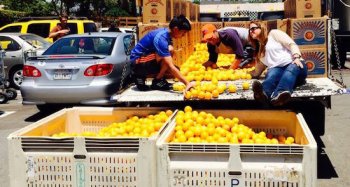
If that number were a state “its population would rest somewhere in between Nevada and New Mexico in size,” says Nahmias.
That is the challenge that Food Forward tackles each and every day by recovering excess fruits and vegetables and donating them to local agencies that feed the hungry.
In five years, the organisation has gone beyond backyard harvests on private properties to become a large-scale food recovery programme that gleans fruit not only from trees, but also from farmers’ and wholesale markets. As a result, Food Forward is now one of the largest food recovery programs in Southern California.
Since its inception seven years ago, the nonprofit has donated 25 million pounds of food; and this year alone it will glean 14 million pounds of produce that will reach people in need across Southern California.
“We are reaching eight counties from San Diego to Santa Barbara, and are now working with over 100 agencies from backyard harvests to farmers’ markets,” says Rick Nahmias, Founder and Executive Director.
It was Nahmias’s frustration with food waste that resulted in the creation of the Food Forward’s Wholesale Recovery Program and subsequent rapid scaling in fresh produce donations.
“The waste is maddening,” says Nahmias. “Our wholesale district starts at the market and goes for a mile or two in any direction. It is the largest food receptacle in the entire continent as far as food that comes in, redistributed and packaged to go out to the rest of the country.”
The Wholesale Recovery Program, which works to reduce waste by collecting unwanted produce from wholesale donors in and around the downtown Los Angeles Wholesale Produce Market, has been operating for two and one-half years and has far exceeded expectations.
“We expected 300,000 pounds the first year, which was a conservative estimate,” says Nahmias. “In reality, it was 4.3 million pounds. Some of this would have gone into other avenues, but, most would have been put in a landfill.”
Food Forward’s operational model also addresses food waste.
“Not a pound of food is picked up or harvested without knowing where it is going ahead of time,” he says. “We don’t collect anything without knowing we have a place for it to go, or a recipient, so nothing is stored. The only refrigerator we have is the one in the Fruit Cave, and that’s for staff and volunteers.”
The organisation wants to do more work beyond Southern California and is working on an education program to bring food waste and hunger issues to the foray in school curriculums. While Food Forward’s growth has been impressive, Nahmias says that it’s really about “measured growth and doing what we do better instead of shot gunning all over the place.” To that end, he explains that while the organization distributes food to eight counties, the great bulk of the gleaning takes place in Los Angles and Ventura counties and is done as efficiently as possible.
Just as it was in the beginning, Food Forward is volunteer driven. There are about 6,000 volunteer shifts per year, with approximately 150 volunteer events a month between the farmers’ market and backyard harvests across Los Angeles and Ventura Counties, resulting in the participation of around 10,000 volunteers cumulatively.
Despite its growth, the philosophy and vision behind Food Forward remains the same: “You take food off a tree and give it to people who need it,” says Nahmias. “It’s very easy to stay connected to that because of the food system that exists here. We have the trees, these farmers’ markets, a one of a kind wholesale market. It is still this idea of giving something without the expectation of getting anything in return. How do people share without having to be patted on the back, that ability is a gift in itself.”
Source: Judith Gerber, Seedstock



 Classifieds
Classifieds

